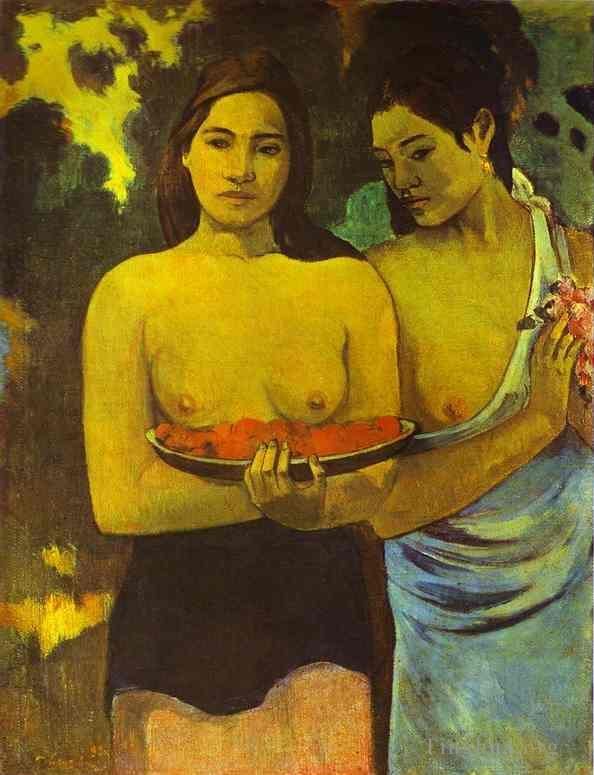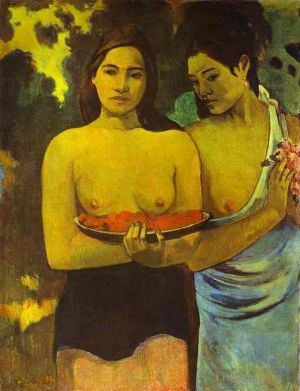Two Tahitian Women
Paul Gauguin
- Price: Price on Request
- Art Type: Oil Painting
- Size:
- English Comments: 0
- International Comments: 0
- Creating Date:
- Introduction and Works of Paul Gauguin >>
Work Overview
- Two Tahitian Women
Artist Paul Gauguin
Year 1899
Medium oil on canvas
Dimensions 94 cm × 72 cm (37 in × 28.5 in)
Location Metropolitan Museum of Art, New York City
Two Tahitian Women is an 1899 painting by Paul Gauguin. It depicts two topless women, one holding mango blossoms, on the Pacific Island of Tahiti. The painting is part of the permanent collection of the Metropolitan Museum of Art in New York City and was donated to the museum by William Church Osborn in 1949.[1]
Although Tahiti is depicted as an innocent paradise, the two women in the painting confront the viewer in a way similar to that in Manet's Le déjeuner sur l'herbe (1863) or Olympia (1863),[2] and follow an artistic tradition of comparing woman's breasts to flowers or fruit.[3] The women in the painting also appear in two other works by Gauguin, Faa Iheihe (Tahitian Pastoral) (1898) and Rupe, Rupe (1899).[1]
The painting was attacked April 1, 2011, while on loan to the National Gallery of Art in Washington D.C. A woman named Susan Burns banged on the painting's plastic cover. Due to the protection of the plexiglass, the painting was not harmed. The woman was “immediately restrained and detained” by the museum’s security guards who charged her with destruction of property and attempted theft.
As Gauguin brought his work in Tahiti to a close, he focused increasingly on the beauty and serene virtues of the native women. In this painting, he depended on sculpturally modeled forms, gesture, and facial expression to vivify the sentiments he had used to describe the "Tahitian Eve": "very subtle, very knowing in her naïveté" and at the same time "still capable of walking around naked without shame." These two figures first appear in the artist's monumental frieze Faa Iheihe (Tahitian Pastoral) of 1898 (Tate, London) and again in the even larger Rupe Rupe (The Fruit Harvest) of 1899 (Pushkin Museum of Fine Arts, Moscow), which he composed for the upcoming Exposition Universelle of 1900.
- Copyright Statement:
All the reproduction of any forms about this work unauthorized by Singing Palette including images, texts and so on will be deemed to be violating the Copyright Laws.
To cite this webpage, please link back here.
- >> English Comments
- >> Chinese Comments
- >> French Comments
- >> German Comments
- >>Report
- Ceramic Vase with a Caricature Self Portrait
- Ceramic vase with Tahitian Gods Hina and Tefatou
- Girl with a Fan
- Te avae no Maria Month of Maria
- Cattle Drinking
- The Call
- Ford Running Away
- Horse on Road Tahitian Landscape
- Three Tahitian Women Against a Yellow Background
- Ta Matete We Shall Not Go to Market Today
- The Seine in Paris between the Pont d Lena and the Pont de Grenelle
- Yellow Hay Ricks Fair Harvest
- Te Vaa The Canoe
- The Seine at the Pont d Iena Snowy Weather
- Day of the God (Mahana No Atua)
- Barbarous Tales
- Fatata te moua At the Foot of a Mountain
- Te Tiare Farani Bouquet of Flowers
- Aube the Sculptor and His Son
- Apple Trees in Blossom
- Baby The Nativity
- Vahine no te vi Woman with a Mango
- Les Alyscamps Arles
- Mandolina and Flowers
- Breton Shepherdess
- Aha oe feii Are You Jealous
- Spirit of the Dead Watching
- The Meal The Bananas
- Mimi and Her Cat
- Tahitian Women On the Beach
- Vahine no te tiare Woman with a Flower
- Joyeusete Arearea
- Siesta
- Bonjour Monsieur Gauguin
- Adam and Eve
- Fatata te miti Near the Sea
- Matamoe Landscape with Peacocks
- The Alyscamps
- The Yellow Christ
- Te Tamari No Atua Nativity
- Madame Alexandre Kohler
- Sunflowers
- Fruits
- Tahitian Landscape
- Piti Teina Two Sisters
- Les Parau Parau Conversation
- Horsemen on the Beach
- Two Breton Women on the Road
- The Fisherwomen of Tahiti
- Merahi metua no Tehamana Ancestors of Tehamana
- La Belle Angele Portrait of Madame Satre
- Te Faaturuma Brooding Woman
- Study of a Nude Suzanne Sewing
- Ia Orana Maria Hail Mary
- Vairumati
- Bouquet of Flowers with a Window Open to the Sea Reverse of Hay Making in Brittany
- Portrait of a Woman with Cezanne Still Life
- Portrait of Gauguin s Daughter Aline
- Mother and Daughter
- Eve Don t Listen to the Liar
- Harvesting of Grapes at Arles Miseres humaines
- Palm Trees on Martinique
- Effect of Snow
- Tahitian Idyll
- Haystacks in Brittany
- Woman Holding a Fruit (Where Are You Going or Eu haere ia oe)
- Taperaa Mahana
- When Will You Marry
- The Four Breton Girls c
- Motherhood Women on the Shore
- Portrait of the Artist with the Idol
- Whats New? (Parau Api or Two Women of Tahiti)
- Hay Making in Brittany
- Still Life with Mangoes
- The Cellist Portrait of Upaupa Scheklud
- Te Pape Nave Nave Delectable Waters
- Man Picking Fruit from a Tree
- 5 Horsemen on the Beach
- At the Pond
- The Schuffenecker Family
- Nevermore O Taiti
- Aita Tamari vahina Judith te Parari Annah the Javanese
- Landscape
- Paysannes bretonnes Breton peasant women
- Still Life with Fan
- Ondine
- Where Do We Come From? What Are We? Where Are We Going?
- Black Pigs
- Rave te hiti aamy The Idol
- Tarari maruru Landscape with Two Goats
- Self portrait
- The Swineherd Brittany
- Bouquet
- Vision of the Sermon (Jacob Wrestling with the Angel)
- Washerwomen at Pont Aven
- Women from Arles in the Public Garden the Mistral
- And the Gold of Their Bodies Et l or de leurs corps
- Scenes from Tahitian Life
- Still Life with Mandolin
- No te aha oe riri Why Are You Angry
- Breton Girls Dancing Pont Aven
- Two Tahitian Women
- Pastorales Tahitiennes
- Parau na te varua ino Words of the devil
- Huts under Trees
- Self Portraits
- Tahitian Woman c
- The Great Buddha
- Breton Landscape The Moulin David
- Night Cafe at Arles
- Portrait of William Molard
- Bouquet of Flowers
- Eiaha Ohipa Not Working
- Three Tahitians
- Self Portrait c
- Van Gogh Painting Sunflowers
- Madeleine Bernard
- Nave Nave Moe Miraculous Source
- Breton Village in Snow
- Portrait de l artiste Self portraitc
- Portrait of Mother
- Caricature Self Portrait
- Nave Nave Moe Sacred Spring
- Vairaumati tei oa Her Name is Vairaumati
- At the Window A la fenetre
- Self Portrait c1894
- Te arii vahine The King s Wife
- Portrait of the Artist with the Yellow Christ
- The White Horse
- Self Portrait 1896
- Be in Love and You Will Be Happy
- Nirvana Portrait of Meyer de Haan
- M Loulou
- Floral and Vegetal Motifs
- Musique barbare
- The Messengers of Oro
- Tahitian Eve c
- Head of a Negress
- Still Life with Three Puppies2
- Words of the Devil c
- Head of a Woman
- Te Arii Vahine Queen
- Study for the Bathers
- Breton Girls Dancing
- Still Life with Three Puppies1
- Tahitian Woman in a Landscape
- Study for La perte de Pucelage The Loss of Virginity
- Pape Moe Mysterious Water









 Singing Palette
Singing Palette